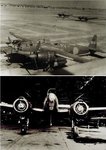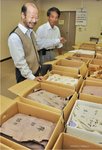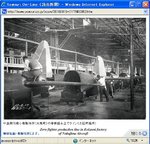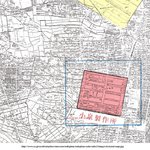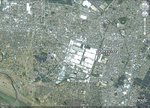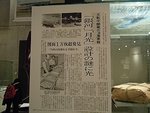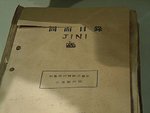Over 10,000sheets blueprints of old navy planes "Ginga(P1Y1 Frances)" and "Gekko(Irving)" discovered.
They were developed during the World War II.
The group manager of science-and-engineering history of technology research group of the National Science Museum in Tokyo, Kazuyoshi Suzuki, discovered 10,000 and more blueprints of the Imperial Japanese Navy aircrafts "Ginga" and "Gekko" last month.
Detailed designs and specifications of such parts as main wing, cockpit and meters are drawn there. It is exceptional that the original data of old weapons has been found in large quantities at a time. Mr. Suzuki says "They are precious data for us to know the Japanese technologies of those days."
The section forms of main and tail wings, the cockpit structure, oil pressure system and the type of used screws which constitute airframes of "Ginga" and "Gekko" are drawn. A carton box of blueprints of the cockpit of "Type 96 land attacker" is also included.
When Mr. Suzuki was searching for any good old data for the coming exhibition, the information "Drawings of old aircrafts have come out in large quantities" was brought by an antiquary early in September. Museum decided to buy the data of twenty carton boxes because they were showing detailed original plans of the lost aircrafts. The drawings are regarded as once having been kept by Koizumi factory (Oizumi-cho, Gumma Prefecture) of Nakajima Aircraft which is known as a manufacturer of the Zero fighter from the stamp on the sheets.
Immediately after the end of the war, the Japanese military issued the command which carries out incineration disposal of the data of aircrafts in order to prevent a technical outflow in the Allies. For this reason, the technology of Japan in wartime has many unknown points, and the industrial history during the war has also become a "blank." Although the 3-view drawings which show the whole body of "Ginga" and "Gekko" from the front, the side, and the upper remained even after the war, the detailed plan for manufacturing the parts had been being considered destroyed.
It is supposed that those engineers who left their names, like Tadanao Miki, as R&D staff of the former Japan National Railroad technical research center for developing the design of Shinkansen in the postwar were also engaged in the development of both aircrafts.
Although the preservation state of drawings is good, the color faded and there are some drawings which cannot be read well. They are going to be restored as the digital images taking time more than one year from now on. As study progresses, the manufacturing technology of those days like the welding method, the accuracy of metalworking or the compatibility of the part etc may become clearer.
Mr. Suzuki says "I did not think that such a lot of drawings like this still remained. It would be an entire mystery why it came out now" and continues "The technology which became the base for our nation's postwar economic development would be understood better by the discovery this time. The significance for knowing the Japanese industrial history, is big."
As for the discovered drawings, some sheets are planned to be displayed at the "Sky and Space Exhibition" of the National Science Museum in Ueno, Tokyo from the 26th of October.
News source Nihon Keizai Shimbun. Newspaper of the electronic version.
2010/10/18 12:04
They were developed during the World War II.
The group manager of science-and-engineering history of technology research group of the National Science Museum in Tokyo, Kazuyoshi Suzuki, discovered 10,000 and more blueprints of the Imperial Japanese Navy aircrafts "Ginga" and "Gekko" last month.
Detailed designs and specifications of such parts as main wing, cockpit and meters are drawn there. It is exceptional that the original data of old weapons has been found in large quantities at a time. Mr. Suzuki says "They are precious data for us to know the Japanese technologies of those days."
The section forms of main and tail wings, the cockpit structure, oil pressure system and the type of used screws which constitute airframes of "Ginga" and "Gekko" are drawn. A carton box of blueprints of the cockpit of "Type 96 land attacker" is also included.
When Mr. Suzuki was searching for any good old data for the coming exhibition, the information "Drawings of old aircrafts have come out in large quantities" was brought by an antiquary early in September. Museum decided to buy the data of twenty carton boxes because they were showing detailed original plans of the lost aircrafts. The drawings are regarded as once having been kept by Koizumi factory (Oizumi-cho, Gumma Prefecture) of Nakajima Aircraft which is known as a manufacturer of the Zero fighter from the stamp on the sheets.
Immediately after the end of the war, the Japanese military issued the command which carries out incineration disposal of the data of aircrafts in order to prevent a technical outflow in the Allies. For this reason, the technology of Japan in wartime has many unknown points, and the industrial history during the war has also become a "blank." Although the 3-view drawings which show the whole body of "Ginga" and "Gekko" from the front, the side, and the upper remained even after the war, the detailed plan for manufacturing the parts had been being considered destroyed.
It is supposed that those engineers who left their names, like Tadanao Miki, as R&D staff of the former Japan National Railroad technical research center for developing the design of Shinkansen in the postwar were also engaged in the development of both aircrafts.
Although the preservation state of drawings is good, the color faded and there are some drawings which cannot be read well. They are going to be restored as the digital images taking time more than one year from now on. As study progresses, the manufacturing technology of those days like the welding method, the accuracy of metalworking or the compatibility of the part etc may become clearer.
Mr. Suzuki says "I did not think that such a lot of drawings like this still remained. It would be an entire mystery why it came out now" and continues "The technology which became the base for our nation's postwar economic development would be understood better by the discovery this time. The significance for knowing the Japanese industrial history, is big."
As for the discovered drawings, some sheets are planned to be displayed at the "Sky and Space Exhibition" of the National Science Museum in Ueno, Tokyo from the 26th of October.
News source Nihon Keizai Shimbun. Newspaper of the electronic version.
2010/10/18 12:04

